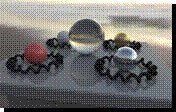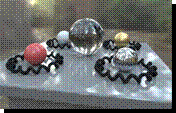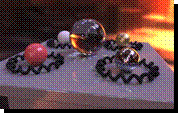CMU 15-463: Computational Photography (original) (raw)
COURSE OVERVIEW:
Computational Photography is an emerging new field created by the convergence of computer graphics, computer vision and photography. Its role is to overcome the limitations of the traditional camera by using computational techniques to produce a richer, more vivid, perhaps more perceptually meaningful representation of our visual world.
The aim of this advanced undergraduate course is to study ways in which samples from the real world (images and video) can be used to generate compelling computer graphics imagery. We will learn how to acquire, represent, and render scenes from digitized photographs. Several popular image-based algorithms will be presented, with an emphasis on using these techniques to build practical systems. This hands-on emphasis will be reflected in the programming assignments, in which students will have the opportunity to acquire their own images of indoor and outdoor scenes and develop the image analysis and synthesis tools needed to render and view the scenes on the computer.
TOPICS TO BE COVERED:
- Cameras, Image Formation
- Visual Perception
- Image and Video Processing (filtering, anti-aliasing, pyramids)
- Image Manipulation (warping, morphing, mosaicing, matting, compositing)
- Modeling and Synthesis using Lots of Data
- High Dynamic Range Imaging and Tone Mapping
- Image-Based Lighting
- Image-Based Rendering
- Non-photorealistic Rendering
PREREQUISITES:
Programming experience and familiarity with linear algebra and calculus is assumed. Some background in computer graphics, computer vision, or image processing is helpful. This class does not significantly overlap with 15-462 and can be taken concurrently.
Graduate Students: a small number of graduate students will be allowed to take the graduate version of this course (15-862) with the permission of the instructor. Students taking 15-862 will be required to do more substantial assignments as well as a research-level final paper.
Note: if the system doesn’t let you sign up, or puts you on the waitlist, do talk to me.
PROGRAMMING ASSIGNMENTS:
TEXT:
This is the first year when we will be using:
Computer Vision: Algorithms and Applications. Richard Szeliski (available online)
Various course notes and papers will be made available. Furthermore, there is an optional textbook that you might find helpful. It will be placed on reserve at the Wean Hall library:
Computer Vision: The Modern Approach, Forsyth and Ponce
There is a number of other fine texts that you can use for general reference:
Photography (8thedition), London and Upton, (a great general guide to taking pictures)
Vision Science: Photons to Phenomenology, Stephen Palmer (great book on human visual perception)
Digital Image Processing, 2nd edition, Gonzalez and Woods (a good general image processing text)
The Art and Science of Digital Compositing, Ron Brinkmann (everything about compositing)
Multiple View Geometry in Computer Vision, Hartley & Zisserman (a bible on recovering 3D geometry) [on reserve]
The Computer Image, Watt and Policarpo (a nice “vision for graphics” text, somewhat dated)
3D Computer Graphics (3rd Edition), Watt (a good general graphics text)
Fundamentals of Computer Graphics, Peter Shirley (another good general graphics text)
Linear Algebra and its Applications, Gilbert Strang (a truly wonderful book on linear algebra)
CLASS NOTES
The instructor is extremely grateful to a large number of researchers for making their slides available for use in this course. Steve Seitzand Rick Szeliskihave been particularly kind in letting me use their wonderful lecture notes. In addition, I would like to thank Paul Debevec, Stephen Palmer, Paul Heckbert, David Forsyth, Steve Marschner and others, as noted in the slides. The instructor gladly gives permission to use and modify any of the slides for academic and research purposes. However, please do also acknowledge the original sources where appropriate.
CLASS SCHEDULE:
| CLASS DATE | TOPICS | Material |
|---|---|---|
| Tu Jan 12 | Introduction  |
Slides (ppt, pdf) |
| Th Jan 14 | The Camera  |
Slides (ppt, pdf) |
| Tu Jan 19 | Capturing Light… in man and machine  |
Slides (ppt,pdf) Forsyth & Ponce, Ch 6 |
| Th Jan 21 | Sampling and Reconstruction  |
Slides (ppt, pdf) |
| Tu Jan 26 | The Frequency Domain  |
Slides (ppt, pdf) |
| Th Jan 28 | Continue with Frequency Domain | Project #2 OUT |
| Th Feb 2 | Image Blending and Compositing  |
Slides (ppt, pdf) AdditionalReading: Burt and Adelson, A multiresolution spline with application to image mosaics, ACM ToG (1983)Agarwala et al, Interactive Digital Photomontage, SIGGRAPH 2004 |
| Th Feb 4 | Point Processing  |
Slides (ppt, pdf) |
| Tu | Image Warping   |
Slides (ppt, pdf) |
| Th | Image Morphing  |
Slides (ppt, pdf) Project #3 OUT |
Data-driven Methods: Faces  |
Slides (ppt, pdf) Rowland and Ferrett, “Manipulating Facial Appearance through Shape and Color”, CG&A, 1995 Additional Reading: Blanz and Vetter, “A Morphable Model for the Synthesis of 3D Faces”, SIGGRAPH 1999 Cootes, Edwards, and Taylor, “Active Appearance Models”, ECCV 1998 | |
| Tu | Modeling Light  |
Slides (ppt,pdf) |
Homographies and Mosaics  |
Slides (ppt,pdf) Paul Heckbert, Projecting Mappings for Image Warping Project #4 OUT | |
| Tu | Automatic Alignment  |
Slides (ppt, pdf) Reading: Brown et al, “Multi-Image Matching using Multi-Scale Oriented Patches”, CVPR 2005 Reading: M. Brown and D. G. Lowe. Recognising Panoramas (ICCV2003) (pdf 820kb) Reading: RANSAC |
| Th | More Mosaic Madness  |
� Slides (ppt,pdf) � AdditionalReading: Rick Szeliski, Image Alignment and Stitching, A Tutorial (DRAFT) |
| Tu | Automatic Alignment  |
Slides (ppt, pdf) Reading: Squaring the Circle in Panoramas Reading: Automating joiners AdditionalReading:Photographing long scenes with multi-viewpoint panoramas AdditionalReading:Scene Collages and Flexible Camera Arrays Flickr: http://flickr.com/groups/joiners/ |
Data-driven Methods: Video and Texture  |
Slides (ppt, pdf) Reading: Schold et al, Video Textures, 2000 Reading: Efros & Lreung, Texture Synthesis by Non-parametric Sampling, 1999 Additional Reading: Image Analogies | |
Data-driven Methods:  |
Slides (ppt, pdf) Reading: Hays & Efros, Scene Completion Using Millions of Photographs Additional Reading: 1. im2gps 2. Creating and Exploring a Large Photorealistic Virtual Space | |
Matting  |
Slides (ppt, pdf) | |
Single View Reconstruction   |
� Slides (ppt,pdf) � Reading: Horry et al, “Tour into the Picture”, SIGGRAPH ‘97 | |
High Dynamic Range Images  |
Slides (ppt,pdf) Reading: Debevec & Malik, “Recovering High Dynamic Range Radiance Maps from Photographs”, SIGGRAPH 1997 | |
Image-based Lighting    |
Slides (ppt,pdf) Reading:Debevec, Rendering Synthetic Objects in Real Scenes, 1998 | |
What makes a Great Picture? + Wrap-up  vs. vs.  |
Slides (ppt,pdf) Reading:Y. Ke, X. Tang, and F. Jing. The Design of High-Level Features for Photo Quality Assessment. CVPR 2006. |
CAMERAS:
Although it is not required, students are highly encouraged to obtain a digital camera for use in the course (one can get a pretty good camera for under $150). A camera might be available on load from the instructor.
METHOD OF EVALUATION:
Grading will be based on a set of programming and written assignments (60%), an exam (20%) and a final project (20%). For the programming assignments, students will be allowed a total of 5 (five) late days per semester; each additional late day will incur a 10% penalty.
Students taking 15-862 will also be required to submit a conference-style paper describing their final project.
COMPUTING FACILITIES: All students will have access to the graphics cluster in Gates Hall. You will need to setup your Andrew account in the right way before you can login.
MATLAB: Students will be encouraged to use Matlab (with the Image Processing Toolkit) as their primary computing platform. Besides being a great prototyping environment, Matlab is particularly well-suited for working with image data and offers tons of build-in image processing functions. Here is a link to some useful Matlab resources
PREVIOUS OFFERINGS OF THIS COURSE:
Previous offerings of this course can be found here.
SIMILAR COURSES IN OTHER UNIVERSITIES:
- Computational Photography (Hays, Brown)
- Computational Photography SIGGRAPH Course (Raskar & Tumblin)
- Computational Camera and Photography (Raskar, MIT Media Lab)
- Digital and Computational Photography (Durand & Freeman, MIT)
- Computational Photography (Essa,GeorgiaTech)
- Computational Photography (Levoy, Adams, Pulli, Stanford)
- Computational Photography (Lazebnik, UNC)
- Computational Photography (Fergus, NYU)
- Internet Vision (T.Berg, SUNY)
- Computer Vision (Seitz & Szeliski, UWashington)
- Instroduction to Visual Computing and Visual Modeling(Kutulakos, UToronto)
- Symposium on Computational Photography and Video (May 2005, MIT)